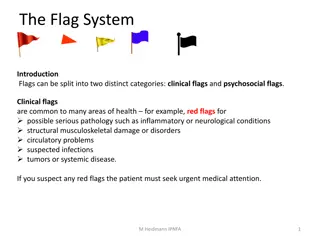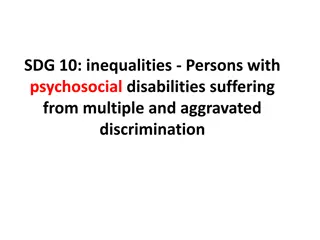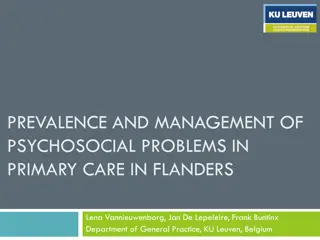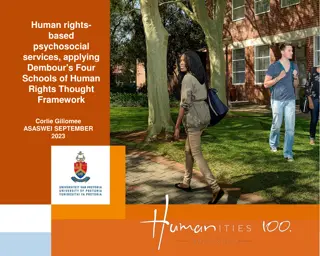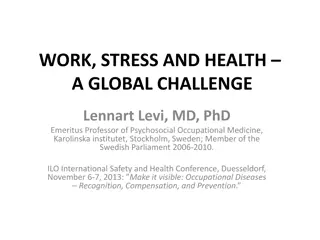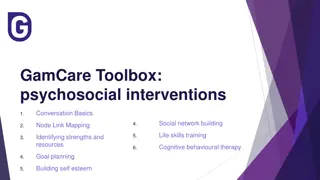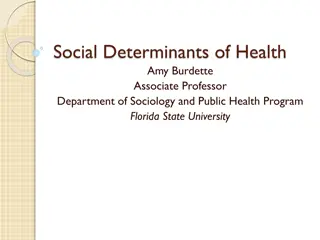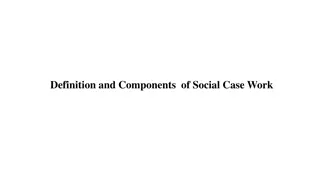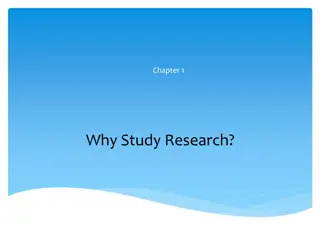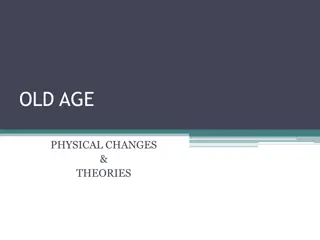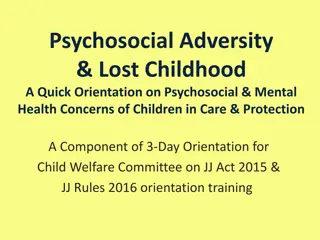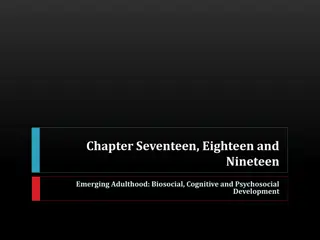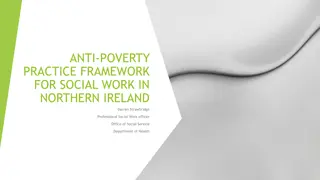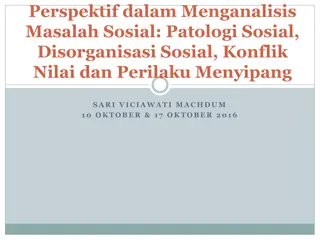Understanding Psychosocial Theory in Social Work Practice
Social work practice has always integrated psychosocial concepts to address human well-being and social functioning. Psychosocial caseworkers aim to help clients navigate challenges stemming from environmental imbalances. The term "psychosocial" refers to the interaction of psychological and societal forces, emphasizing the interconnectedness between individuals and their environments. Psychosocial theory posits that an individual's behavior is influenced by both psychological and social factors, necessitating interventions that address both aspects.
Download Presentation

Please find below an Image/Link to download the presentation.
The content on the website is provided AS IS for your information and personal use only. It may not be sold, licensed, or shared on other websites without obtaining consent from the author. Download presentation by click this link. If you encounter any issues during the download, it is possible that the publisher has removed the file from their server.
E N D
Presentation Transcript
Psychosocial Theory and Social Work Practice Dr. IMRAN A. SAJID Social Work Department Peshawar University Source: Woods, M.E., and Robinson, H. (1996). Psychsocial theory and social work treatment (555-580). In Francis J. Turner. (Ed). Social Work Treatment, 4th Edition. The Free Press. 1
Introduction All social work practice-historically and currently-has relied on psychosocial concepts. From the very beginning, social work has been dedicated to; the alleviation of sufferings and to the enhancement of human life. Social Workers had been concerned about; How to enhance the well-being of individuals and families? How to respond to people s need? How to restore social functioning ?and How to better their interpersonal relationships and life situations. In order to answer these questions the psychosocial approach grew up in social work practice. 2
Psychosocial caseworkers (now sometimes referred to as clinical social workers) seek to help clients individuals, families, and larger groups to reduce problems arising from some kind of disequilibrium between them and their environments. A fundamental step in the psychosocial method is the study of individuals and families, their impinging environments, and the person-in-situation gestalt so that meaningful assessments or diagnoses of these can be formulated. 3
Meaning of Psychosocial The term Psychosocial, 1st used in 1899, means, pertaining to mind and society . Relating Social Conditions to Mental Health . Merriam Webster Dictionary. The term psychosocial is the combination of two words, psycho means psychological and social means relating to society, or the way in which people in groups behave and interact . So in this context psychosocial means interaction of psychological and societal forces / components . 4
1930 Hankins seems to coin the term psychosocial in paper Contributions of Sociology to Social Work, presented at the National Conference of Social Workers, in Chicago 1940 Gordon Hamilton used the term psychosocial in her book Theory and Practice of Social Case Work 5
Psychosocial theory Psychosocial theory says that individual and his environment are intertwined. Changes in one system creates changes in other systems. In other words individual s behavior is the product of psychological forces and societal factors. His problem triggers not only due to psychological forces or social factors but by the combination of both. Therefore the intervention strategy must address both the factors. 6
Clients context The client s context is made up of many interacting systems not only one system including psychological, social, family, personality, school, work place etc. 7
Problem Problems is seen as a consequence of disequilibrium between individual and environment. What psychosocial caseworkers do to solve the problems is, to help client reduce the disequilibrium between individual and their environment. 8
Aim of Treatment The psychosocial treatment often is not aimed at the so- called pathological or dysfunctional aspects of the gestalt; rather, interventions are tailored to address those aspects that are most accessible and most capable of change. Ameliorization of the client s environment may result in enduring changes in the personality or family system. 9
The Goal of Psychosocial Workers The goal of psychosocial workers are to work collaboratively with clients to find optimal fits between people and their social or physical surroundings. 10
Historical Origin and Development Social work has always been profoundly influenced by the conditions and demands of the day. During some periods, socioeconomic forces received the greatest attention; at other times, there was keener interest in understanding personality development and functions. As our theory and knowledge base matured, the tendency to neglect either component diminished significantly. 11
Historical cont; Mary Richmond: She set the stage for the development of modern casework theory and practice. When she published her first book, friendly visiting among the poor: a handbook for charity workers , in 1899, she began formulating and evaluating practice concepts and techniques. Some of her majors ideas and findings are as follows: 12
History cont; Mary Richmond: 1. Focus on the individual alone did not always help. Social relations and environment-past and present-are major forces shaping personality External influence had to be addressed in order to promote a better adjustment between individual and the surrounding. 2. Caseworkers actual experience should be subjected to critical analysis, and their efforts must be measured by best standards available. She outlined specific approaches to collection of social evidence from which inferences were to be drawn, leading to social study, diagnosis, and treatment planning process. 3. Treatment must be individualized. She cautioned against generalization and stereotyping. Each person and each family is unique and must be studied and listened to separately. 13
History cont; Knowledge from Psychology and Psychiatry: Psychology and psychiatry prevailed over social workers during WW-I up till 1950s. During 1920 s the sociological basis of social work was partially obscured by new ideas of personality development, and emotional experiences etc. Freud s thinking were particularly influencing. Inner weakness was too often blamed for miseries or crises that were primarily social in origin. Family and socioeconomic influence was downplayed. Ego Psychology: All approaches in ego psychology broadens the psychosocial casework horizon. Particularly defense mechanism of Anna Freud, Erikson s psychosocial developmental stages, Client-Centered therapy of Roger, and cognitive therapy are more important. It postulated that neurosis is actually social in origin Knowledge from Social Science Custom and Behaviour 1930s and 40s Anthropologists Ruth Benedict & Margaret Mead vast differences among cultures in customs relating to childrearing, marriage, sexual behaviour and roles, treatment of the elderly etc. Cloward (1959)Political powerlessness, social deviance, closed oppertunity structures etc 14
Principles and Assumptions 1. People of all ages have the capacity to grow, learn, adapt and-at least to some degree-modify their social and physical environment. 2. Psychological systems do not stand alone, but constantly interact with biological and social systems. E.g. The process of aging or changes in health affect the personality; the stability or instability of the personality influences the health or the course that aging process takes Psychosocial workers address all relevant systems biological, social, and psychological that influence a person s situation. 3. People s behavior develop within the context of many open systems interacting in mutually causative ways. Change in one system inevitably creates changes in other systems. When a parent is laid off from work, stress is placed on the whole family, a stress that a child may act out by misbehaving in school. 15
Principles and Assumptions cont; 4. Family system provides most significant context for personality growth and development. Problems of fit among family members parents with children, husbands with wives, siblings with siblings are mutual. 5. Families are also subjected to stresses that come from larger systems, including poverty, racism, etc. the daily lives of many clients are pervaded by these forces. Community and social resources provides a holding environment for families. 6. People ascribe individual and collective meanings to events and situations. How people view and interpret their lives, find a sense of self and define their purposes is, in part, culturally influenced. Ethnic sensitivity on the part of social worker is essential 16
Principles and Assumptions cont; Assumptions from Ego psychology : 1. Significant feelings and thoughts lie outside of awareness. 2. Personality is fluid and dynamic system of forces that influences behaviour; 3. Defenses are constructed that serve bother positive and negative end. 4. Symptoms are adaptive attempts to uncover and resolve internal conflicts. 5. Neurosis is actually social in origin. 17
The Worker Client Relationship Successful treatment depends heavily on the quality of relationship between client and worker. How to promote Positive Relationship? Positive therapeutic relationship stems from the worker s demonstration of non-possessive warmth and concern, genuineness, accurate empathy, and non-judgmental acceptance, along with his capacity to communicate optimism and professional competence. For client: he must mobilize some courage, hope and motivation to join the worker, and to trust in his ability to help. 18
The Worker Client Relationship cont; Obstacles in effective worker-client relationship: Numerous obstacles stand in the way of effective worker-client relationship; People seeking help feel anxious-with feeling of shame and failure to resolve difficulties. Fear of dependence on another may create apprehension Anticipatory fear- that the worker truly can not understood their need or circumstances can also hinder effective relationship. When the client is referred by some referring agency-e.g. parents, school, court etc-in that case the client s willingness to engage in work may be impeded. 19
Approaches to Intervention The approaches to intervention includes; Psychosocial Study Psychosocial Assessment Psychosocial Intervention 20
Approaches to Intervention cont; 1. Psychosocial Study Gathering Facts vs. Interpreting Facts The primary emphasis in psychosocial casework is placed on understanding the client s dilemmas and what has contributed to them. This understanding is called psychosocial study. It requires observation and gathering of accurate facts that are arranged in orderly manner. Often the bulk of data is obtained in early interviews. 21
Approaches to Intervention cont; Initial Interviews Facts gathering begins as the worker elicits from clients their perception of problems, what they think led up to it, how they have attempted to remedy it, what they believe might help now, and what other people, agencies or systems are involved. Additional Source of Information Observations of the clients nonverbal behaviors and demeanor and the dynamic of the client-worker relationships, usually prove useful. The goal is fact gathering, not interpretation. The psychosocial study of children requires collateral interviews with parents, teachers, and other concerned. 22
Approaches to Intervention cont; Early Life History Many problems in living emerge during the developmental phases of the individual and family life cycle. Therefore early life history is also obtained for psychosocial study. 23
Approaches to Intervention cont; Psychosocial Assessment: Psychosocial assessment begins by thinking critically about the facts gather in psychosocial study. The worker s task, now, is to conceptualize how the multiple symptoms are interacting. Assessment simultaneously addresses and formulates hypotheses about two major matters; 1. How and why a problem exists, and 2. Who and what is accessible to change. Only after determining where we can enter the constellation of multiple systems, and which system or systems are probably most amenable to change, can effective treatment strategies be designed. Assessment identify points of access and evaluate the capacity, motivation, and opportunity for change-of individual, the family, the social networks, and communities. 24
Approaches to Intervention cont; Psychosocial Intervention Psychosocial treatment often uses a blend of individual, couple, family and environmental modalities. In work with symptomatic children, family members are often the most important resources for change. 25
Recap Individual and his environment are intertwined. Changes in one brings changes in others. Problems is the disequilibrium between individual and his environment. The worker s goal is to work collaboratively with the client and find an optimal fit between individual and his physical and social surroundings. 26
Thank you 27


